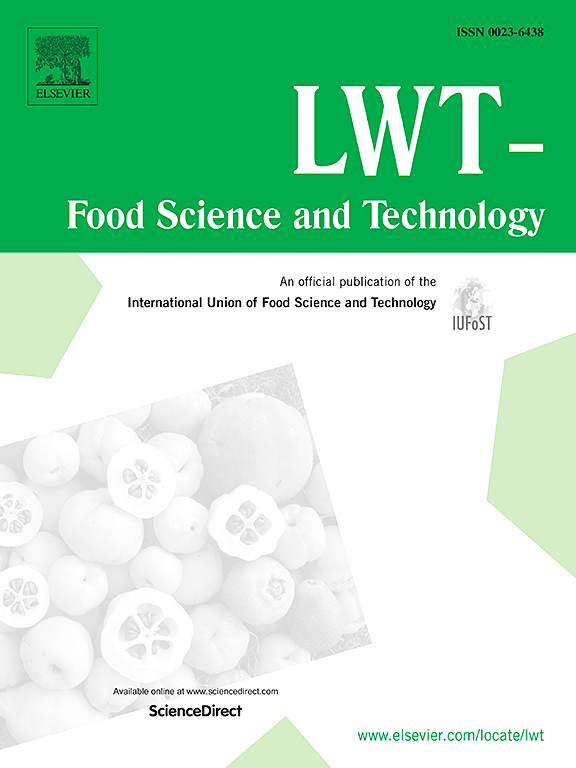蛋白质-酚酸复合物对冰淇淋结构和融化行为的影响
IF 6.6
1区 农林科学
Q1 FOOD SCIENCE & TECHNOLOGY
引用次数: 0
摘要
本研究的重点是了解蛋白质-酚酸复合物对冰淇淋结构变化和融化行为的影响。分别研究了两种浓度(2 毫克/克和 10 毫克/克)的三种酚酸(4-羟基苯甲酸、香草酸和没食子酸)。与对照冰淇淋相比,2 毫克/克和 10 毫克/克的酚酸分别使第一次滴水的诱导时间延长了 175-200% 和 200-292%。与其他处理相比,添加 10 毫克/克没食子酸和香草酸的冰淇淋融化率最低。添加酚酸会降低冰淇淋的 pH 值(4.92-6.13)、溢出率(23.11-69.02%)、稠度系数(9.47-175.56 Pa sn)和熔化焓(154320-193330 J/kg),同时增加表观粘度(478.37-8770.17 mPa s)、流动性指数(0.42-0.62)和脂肪球大小(2.22-10.53 μm)。对冰淇淋混合模型进行的荧光光谱分析表明,蛋白质与酚酸之间存在相互作用。用 SDS 和 EDTA 处理的冰淇淋样品的显微镜图像进一步表明,蛋白质与酚酸的相互作用有助于产生脂肪聚集。这些研究结果表明,在冰淇淋混合料中添加酚酸会影响其微观结构,因为酚酸会生成蛋白质-酚酸复合物,导致蛋白质介导的脂肪聚集,从而改变冰淇淋的粘度特性,降低融化率。本文章由计算机程序翻译,如有差异,请以英文原文为准。
Effect of protein-phenolic acid complexes on ice cream structure and meltdown behavior
This study focused on understanding the effects of protein-phenolic acid complexes on structural changes and meltdown behavior in ice cream. Three phenolic acids (4-hydroxybenzoic acid, vanillic acid, and gallic acid) at two concentrations (2 and 10 mg/g) were individually investigated. Compared to control ice cream, 2 and 10 mg/g phenolic acid increased the induction time for the first drip by 175–200% and 200–292%, respectively. Ice cream with gallic acid and vanillic acid at 10 mg/g exhibited the lowest meltdown rates compared to other treatments. Addition of phenolic acids caused reduction of ice cream pH (4.92–6.13), overrun (23.11–69.02%), consistency coefficient (9.47–175.56 Pa sn), and melting enthalpy (154,320–193,330 J/kg), while increasing the apparent viscosity (478.37–8770.17 mPa s), flow behavior index (0.42–0.62), and fat globule size (2.22–10.53 μm). Fluorescence spectroscopy analysis of a model ice cream mix indicated the presence of protein-phenolic acid interactions. Microscope images of ice cream samples treated with SDS and EDTA further suggested that protein-phenolic acid interactions help create fat aggregation. These findings indicate that addition of phenolic acid to an ice cream mix affects its microstructure by generating protein-phenolic acid complexes that cause protein-mediated fat aggregation, altering the ice cream's viscosity properties and resulting in a lower meltdown rate.
求助全文
通过发布文献求助,成功后即可免费获取论文全文。
去求助
来源期刊

LWT - Food Science and Technology
工程技术-食品科技
CiteScore
11.80
自引率
6.70%
发文量
1724
审稿时长
65 days
期刊介绍:
LWT - Food Science and Technology is an international journal that publishes innovative papers in the fields of food chemistry, biochemistry, microbiology, technology and nutrition. The work described should be innovative either in the approach or in the methods used. The significance of the results either for the science community or for the food industry must also be specified. Contributions written in English are welcomed in the form of review articles, short reviews, research papers, and research notes. Papers featuring animal trials and cell cultures are outside the scope of the journal and will not be considered for publication.
 求助内容:
求助内容: 应助结果提醒方式:
应助结果提醒方式:


